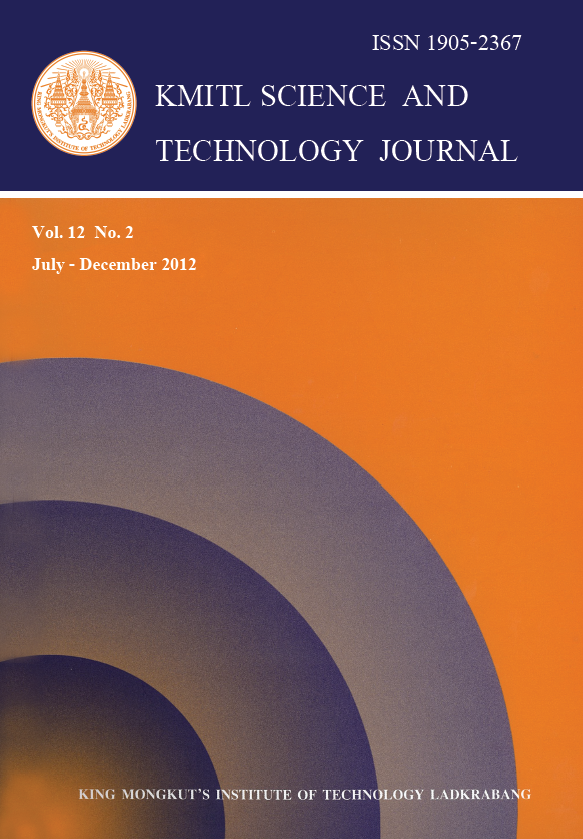Visualization of Conjugate Natural Convection in a Square Enclosure Divided by Conducting Partition
Main Article Content
Abstract
Simulation of conjugate natural convection in a square enclosure with a partition placed at the middle of the enclosure has been performed on FlexPDE 6.19 Student Version. The partition divides the enclosure into two regions and each region is filled with fluid-saturated porous media.The purpose of this study is to investigate the flow field and temperature distribution regarding the change of governing parameters, Rayleigh number (Ra), thermal conductivity ratio (k) and partition thickness (D). It is found that the intensity of circulation increases as Ra or k increases, simultaneously, the increase of k results in the lower temperature distribution along the partition. Moreover, partition thickness reduces the temperature distribution along the right-hand side of partition when the convection is obstructed.
Keywords: Conjugate natural convection, porous media, finite element method, partitioned enclosure
E-mail: supot_wa@kku.ac.th
Article Details
Copyright Transfer Statement
The copyright of this article is transferred to Current Applied Science and Technology journal with effect if and when the article is accepted for publication. The copyright transfer covers the exclusive right to reproduce and distribute the article, including reprints, translations, photographic reproductions, electronic form (offline, online) or any other reproductions of similar nature.
The author warrants that this contribution is original and that he/she has full power to make this grant. The author signs for and accepts responsibility for releasing this material on behalf of any and all co-authors.
Here is the link for download: Copyright transfer form.pdf
References
[2] Tanmay, B., Roy, S, Amit, S. and Bishhun, D.P., 2009. Natural convection flow simulation for various angles in a trapezoical enxlosure with linearly heated side wall(s), International Journal of Heat and Mass Transfer, 52, 4413-4425.
[3] Roy, S., and Tanmay, B., 2005. Finite element analysis of natural convection flows in a square cavity with non-uniformly heated wall(s), International Journal of Engineering Science, 43, 668-680.
[4] Ram, S.K., Tanmay, B. and Roy, S., 2010. Heatline approach for visualization of heat flow and efficient thermal mixing with discrete heat sources, International of Heat and Mass Transfer, 53, 3241-3261.
[5] Asan, H., and Namli, L., 2000. Laminar natural convection in a pitched roof of triangular cross-section: summer day boundary conditions, Energy and Building, 33, 69-73.
[6] Asan, H., and Namli, L., 2000. Numerical simulation of buoyant flow in a roof of triangular cross-section under winter day boundary conditions, Energy and Building, 33, 753-757.
[7] Hakan, F.O., Yasin, V. and Ahmet, K., 2007. Laminar natural convection heat transfer in a shed roof with or without eave for summer season, Applied Thermal Engineering, 27, 2252-2265.
[8] Sompong, P. and Witayangkurn, S., 2011. Numerical study of natural convection in a triangular roof in which the temperature outside the roof is hot, Laos Journal on Applied Science, 2, 391-397.
[9] Amaresh, D, and Manab, K.D., 2005. Laminar natural convection in an inclined complicated cavity with spatially variable wall temperature, International of Heat and Mass Transfer, 48,3833-3853
[10] Amaresh, D, and Manab, K.D., 2006. Natural convection in a cavity with a wavy wall heated from below and uniformly cooled from the top and both sides, ASME Journal of Heat Transfer, 128, 717-725.
[11] Amaresh, D, and Manab, K.D., 2008. Heatline method for the visualization of natural convection in a complicated cavity, International of Heat and Mass Transfer, 51, 263-272.
[12] Sompong, P. and Withyangkurn, S., 2012. Simulation of natural convection in a complicated enclosure with two wavy vertical walls, Applied Mathematical Sciences, 6(57), 2833-2842.
[13] Orhan, A., 2006. Conjugate heat transfer analysis of double pane windows, Building and Enviroment, 41, 109-116.
[14] Majed, M. A., 2006. Analysis of coupled natural convection-conduction effects on the heat transfer through hollow building blocks, Energy and Buildings, 38, 515-521.
[15] Abdullatif, B.N. and Mohamed, A.M., 2007. Conjugate natural convection in the roof cavity of heavy construction building during summer, Applied Thermal Engineering, 27, 287-298.
[16] Nawaf, H.S., 2007. Conjugate natural convection in a porous enclosure: effect of conduction in one of the vertical walls, International Journal of Thermal Sciences, 46, 531-539.
[17] Nawaf, H.S., 2007. Conjugate natural convection in a vertical porous layer sandwiched by finite thickness walls, International Communications in Heat and Mass Transfer, 34, 210-216.
[18] Yasin, V., Hakan, F.O. and Ioan, P., 2009. Conjugate heat transfer in porous triangular enclosure with thick bottom wall, International Journal of Numerical Methods for Heat &Fluid Flow, 19(5), 650-664.
[19] Yasin, V., Hakan, F.O., Moghtada, M. and Ioan, P., 2010. Visualization of heat flow using bejan’s heatline due to natural convection of water near 4 C in thick walled porous cavity,International Journal of Heat and Mass Transfer, 53, 1691-1698.
[20] Hakan, F.O., Zepu, Z. and Bo, Y., 2009. Conduction-combined forced and natural convection in lid-driven enclosures divided by a vertical solid partition, International Communications in Heat and Mass Transfer, 36, 661-668.
[21] Kamil, K., 2007. Numerical simulation of natural convection in a partitioned enclosure using PDQ method, International Journal of Numerical Methods for Heat & Fluid Flow, 17(4),439-456.
[22] Hakan, F.O., Yasin, V. and Ahmet, K., 2009. Natural convection in a vertically divided square enclosure by a solid partition into air and water regions, International Journal of Heat and Mass Transfer, 52, 5909-5921.


